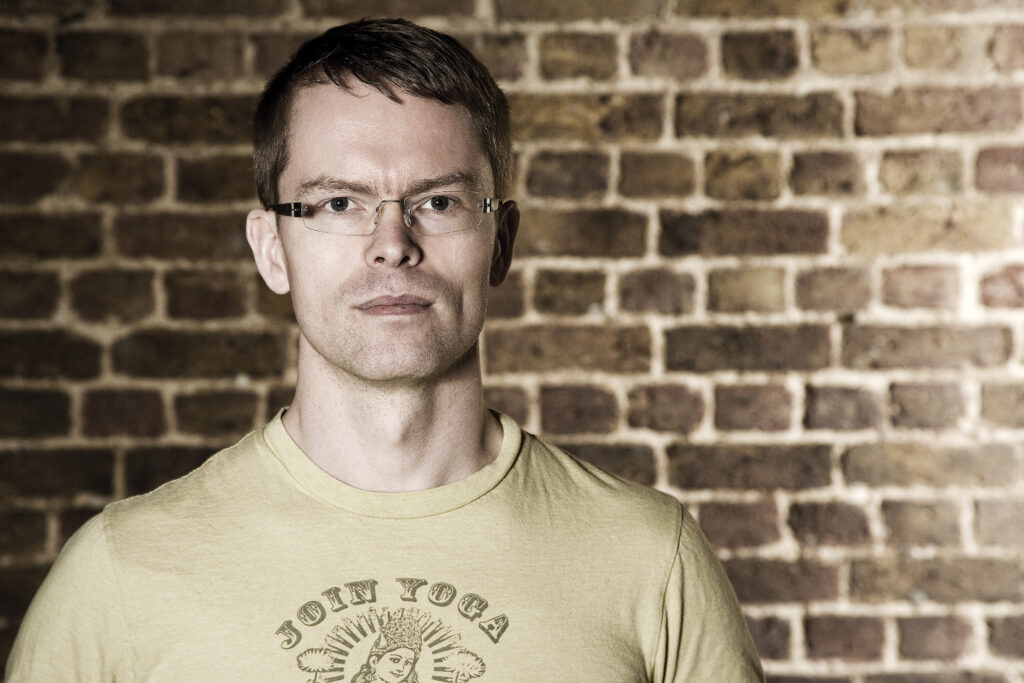When it comes to techno legends, the UK can’t do much better than Surgeon. Based in Birmingham for much of his career, the man born Anthony Child first surfaced in the early ’90s with an eponymous EP which received air from the likes of Jeff Mills and Dave Clarke. His production work has since been of a consistently high calibre, forging its own paths on labels including Downwards, Tresor, Counterbalance and Dynamic Tension. But production is far from the full extent of Childs’ oeuvre. Since co-founding Birmingham’s first techno party, House Of God, in ’93 (it celebrated its 17th anniversary this year), his presence as a DJ of international standing has rarely faltered.
Surgeon’s contribution to the Fabric mix series, out this month, is a fascinating and varied thing, rammed full of left-field tune selection as well as solid dancefloor wizardry. In line with his bent for eclecticism, it manages to roam from relatively straight up minimal by the likes of Robert Hood to creations from UK upstarts Ital Tek and Subeena; all without sounding the slightest bit contrived. Perhaps the highlights, though, are Surgeon’s own productions peppered throughout, proving that he’s still very much at the top of his game in every respect.
Off the back of Fabric 53, Surgeon has kindly thrown together a little something for The Quietus. The resultant 30-minute minimix offers a glimpse into Childs’ supremely eclectic listening habits, taking in Scott Walker, Whitehouse, Depeche Mode and more; check it out below. The Quietus shot Surgeon some questions via email to get the lowdown on peaks, troughs and techno DNA.
_Download our Surgeon mix here._
Firstly, I’d like to ask about Fabric 53. What was your process in putting it together?
Surgeon: I put it together from the tracks that I was playing in my DJ sets at the time I made the mix. I wanted it to reflect some of the mixture of styles I play and feature some newer artists whose work I enjoy alongside more established producers.
Were you conscious of the legacy of the Fabric series? Did that in any way influence your approach to the mix?
S: Not at all. Before completing the mix I’d only heard the one by Robert Hood.
In an interview last year, you said that ‘doing it for the money, celebrity, to be like someone else, to get laid, for attention, to be liked. Those are some of the driving forces for shit music.’ Putting out a Fabric mix could be seen as one of the great accolades of electronic music these days; did you feel the need to approach it with caution for fear that it might compromise your creative integrity in some way?
S: A Fabric mix is a wider platform to present the music and form I believe in for sure. I approached this project in the same pure and focused way that I always use. No need for any fear of compromise, that’s never an option.
The mix showcases an interesting intersection in current electronic music between broken beat and four to the floor; Starkey and Anneka’s ‘Stars’, for example, is a pretty far cry from techno but manages to slide into the mix nicely. Is this something you’ve been exploring a lot lately?
S: I’ve been mixing different music into my DJ sets for many years now (usually to the disgust of techno purists). It seems so sad to limit yourself in that way. If a piece of music moves me, I want to share it with others by playing it in my DJ sets. It’s all techno to me anyway; the whole mix has techno DNA running through it.
Your style of mixing is often quite hands-on, with extended layering of tracks; would you say that, for you, the overall impression of the mix should overshadow the significance of any individual tracks that might be in it?
S: The whole mix is the overall ‘story’: some tracks lead from one section to another, whereas other tracks are more significant points in the mix. (Well, that’s the way I see it.)
Some original Ardkore and Techno DJs would say that a set should be several hours long rather than just one, in order to give the DJ real control over how a night unfolds. Is this a view you subscribe to, and did you feel restricted in assembling a 70 minute set?
S: Yes, I’d say that’s true in a club setting, though with a mix CD I’m able to compress a lot more into that duration. I didn’t feel restricted, so I think I was able to make my point in that time.
I’ve spotted you’ve been doing a lot of live audio/visual sets recently. What’s your view on the role of visuals in club music?
S: The live A/V sets have been great. They create a much more complete experience by having the music and visuals working in synergy. Visuals can work well in clubs when the music and visuals work together and give something powerful. However, when the music and visuals are pulling in opposite stylistic directions, I’d rather perform in a completely dark room.
How do you view the relationship between your production and DJing activity; does one feed into the other?
S: DJing informs the club music I produce for sure. I have been releasing a lot less music since adopting digital DJing methods. Before that, I released new music so that I could play it. Now I don’t have to.
Are there any new Surgeon releases on the horizon?
S: Not right now, but I’m going to start working on new material when I return home in August.
Mick Harris [Scorn/ex-Napalm Death] is another of electronic music’s great individuals, and also somebody whose interests straddle industrial music and dance music. Could you talk about your relationship with him, and how that influenced you early on (and perhaps since then too)?
S: Mick has always been a powerful catalyst. He let me use his studio to produce the first Surgeon tracks when I had no studio of my own. He also introduced me to Karl O’Connor who released those early tracks and with whom I worked for many years. Mick’s energy and enthusiasm are infectious.
Having been on the scene for so long, what do you think has changed in that time; anything fundamental, or is it essentially the same landscape with different scenery?
S: I’ve seen many fads come and go, yet the fundamentals of what move people remain the same. It goes deep into human character and connects at a deep level. That makes me wholly optimistic.
Do you feel locked in to the various stylistic peaks and troughs that go on within electronic dance music, or do you consider yourself set apart from that?
S: I’m aware of what’s going on, and I still like to keep an ear open to new music, but very much use my own judgement about what to adopt and assimilate. I ride out the peaks and troughs.
Finally, could you talk a bit about the minimix you did for the Quietus – it seems like quite a motley assortment of tunes, what was your thinking when putting it together?
S: It was as if my iPod was on shuffle, just giving an idea of a random selection of some of my favourite songs at that moment. I really enjoy putting together those eclectic radio mixes; I’ll have to put together more of them.
The mix suggests that you have a deep interest in music outside of the continuum of dance music; something you’ve talked about in the past. How important is it for you to get that perspective outside of the music you’re making and DJing?
S: It’s just something that’s always been there: an interest in many kinds of music. Dance music is very effective as it is very powerful on the physical level, but that’s not all there is of course. I love discovering new artists and styles I was previously unaware of; it’s like finding buried treasure.
Exclusive Mix Track List
- Oneohtrix Point Never – Actual Air – No Fun Productions
- Coil – All The Pretty Little Horses – Threshold House
- Scot Walker – Big Louise – Fontana
- Autechre – know(1) – Warp Records
- Depeche Mode – Blue Dress – Mute Records
- Nick Drake – River Man – Island Records
- Santana – Singing Winds, Crying Beasts – Columbia
- Whitehouse – The Way It Will Be – Susan Lawley
Podcast: Play in new window | Download



